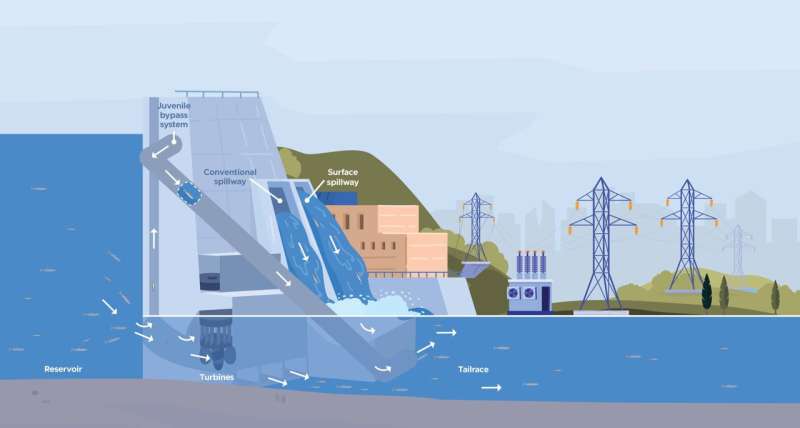This article has been reviewed according to Science X's editorial process and policies. Editors have highlighted the following attributes while ensuring the content's credibility:
fact-checked
trusted source
proofread
Insights into water flow and fish passage through dams offer options for meeting energy, environmental needs

Hydropower dams provide reliable renewable energy, but they also have a direct impact on the environment, especially fish. Adjusting the amount of water spilling over a dam can help fish successfully navigate dams. But spilling more water means less water is available to produce power.
Determining when and how much water to spill to help fish pass safely through dams while meeting grid reliability needs are critically important questions.
Research at Pacific Northwest National Laboratory (PNNL) highlights the complex dynamics around spill and fish passage through dams, and finds that spill is not always the biggest factor in successful fish passage. The research is published in the Canadian Journal of Fisheries and Aquatic Sciences.
"We found that fish activity, swimming ability, and time of day all play a role in fish passage, often more so than spill levels alone," explained PNNL Earth scientist Ryan Harnish.
"Our data show that when young salmon and steelhead are less active in the spring—like at night or in cooler water temperatures—spilling more water can make a big difference in helping more fish avoid passing through the powerhouse. But under other conditions, higher spill levels have little effect."
This is valuable information for decision-makers who are tasked with balancing water needs for environmental health and energy demand. Knowing when high spill levels best support fish passage—and when they don't—provides options for balancing the tradeoffs associated with hydropower generation and environmental impacts.
Tracking fish through a dam in 3D
Spilling water can help fish swim successfully over a dam instead of directly through the powerhouse—the part of the dam that includes the turbine. But the timing and amount of water spilled affects both fish passage and power generation. To take a closer look at how spill level affects fish passage, researchers needed detailed tracking information showing when and how fish passed through a dam.
The standard tracking method in the Columbia River Basin is to tag individual fish with passive integrated transponder (PIT) tags above the dam, which are detected as fish pass through a specific part of the dam called the juvenile bypass system.
While very reliable, this approach doesn't provide information about the various other routes fish can travel through a dam—information needed to determine how spill level affects fish passage. To get this information, numerous studies were conducted between 2008 and 2018 using a different method: acoustic telemetry.
The PNNL team analyzed the 10 years of acoustic telemetry data, including 3D information on fish behavior, from multiple dams along the Snake and Columbia rivers. This allowed them to identify the route fish took through the dam and the precise time of their dam passage. Combined with information about fish behavior and survival along with dam operations, they evaluated what factors were most likely to affect fish passage through different routes and conditions.
They specifically looked at spring salmon and steelhead smolts—young fish migrating toward the ocean—to see how spill levels affected the number of smolts passing directly through the powerhouse. The number of smolts passing through the powerhouse turned out to be related to their activity level and swimming ability, not just spill.
"High spill levels that are intended to reduce the number of fish passing through the powerhouse in the spring are likely to be most effective when fish are less active or have reduced swimming ability, such as at night, during high river flows, or in cooler water temperatures," explained Harnish. "High spill levels were not the single most important factor in smolt passage across the board."
These findings point to the need for more studies like this that can provide comprehensive information about exactly when and how fish pass through dams. That information can help decision-makers determine how to best support fish passage and meet energy needs in the future.
In a statement provided to PNNL, the Bonneville Power Administration (BPA)—which markets power from 31 federal dams across the Pacific Northwest—said, "This publication is another piece to the puzzle of understanding fish passage through the federal hydrosystem. It should provide the region's scientists and managers with additional information to consider when evaluating operations that meet the multiple purposes of the Columbia River System."
Balancing needs
Hydropower generates over half of the electricity in Oregon and Washington and is a key part of a reliable electric grid. Fish passage is necessary to support regional fish populations, particularly salmon, which hold significant environmental, economic, and cultural importance. Knowing when and how much to spill—or not—is paramount to balancing these needs.
For example, when river water levels are low, maximum spill levels are relatively high. This high spill level translates to a big decrease in power generation—equivalent to powering half a million fewer homes.
This study predicts that under these river conditions, maximum spill levels would help fish passage through the powerhouse at night, but would make little difference during the day when energy demand is typically higher. This detailed information offers critical insight for decision-makers and dam operators looking for ways to meet both energy and environment priorities.
"Evaluating energy and environment tradeoffs is a challenge that requires the best available data to inform decisions," said Alison Colotelo, PNNL Hydropower Program Lead. "Better understanding of what affects fish passage through dams and the role of spill is critical to supporting fish populations and power generation."
More information: Ryan A. Harnish et al, Factors affecting powerhouse passage of spring migrant smolts at federally operated hydroelectric dams of the Snake and Columbia rivers, Canadian Journal of Fisheries and Aquatic Sciences (2023). DOI: 10.1139/cjfas-2022-0217
Provided by Pacific Northwest National Laboratory


















